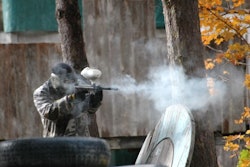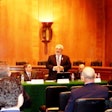The Florence gang was spawned in the Florence District of South Central Los Angeles in the late 1940s and took its name from Florence Boulevard, which runs through central L.A. to the city of Downey and the 605 Freeway. In this predominantly black community the original Latino minority rooted in small postwar low-income housing competed with the African-American gangs to exist. The Florence gang, Florencia in Spanish, grew up tough and grew up mean.
Florence adopted the 1950s doo-wop song "Florence" by the Paragons as its theme song and warred with all the surrounding Latino and black gangs. Even though they often fought African-American gangs, they also did business with them. And F-13 established itself early in the drug trade, dealing with Mexican sources and surrounding gangs.
By the time I got out of grammar school in South Central in 1960, Florence was a huge gang stretching from central L.A. to the city of Huntington Park in eastern Los Angeles county.
At the time Florencia even had a few African-American, but culturally Mexican, members. I remember talking to one of them in Roosevelt Park in the late 1970s. He obviously did not realize that gangs were really a perversion of the Mexican culture. He was completely immersed in the Latino "Cholo" culture; he even spoke with a Mexican accent.
While working the first Operation Safe Streets (OSS) target gang, Compton Varrio Tres, I learned young Latino females were being drugged and seduced sexually by a 33-year-old Florence gang member with Mexican Mafia connections. The suspect was Arthur "Tudy" Picaso and informants said he looked like "an old bald-headed pervert" with a very black "felony brush" mustache. He made his living pushing Mexican heroin. He could cross over from rival F-13 turf to CV3 turf because of his Mexican Mafia association. Informants from the neighborhood soon gave me his vehicle description, and I kept an eye out for him.
A few weeks later, I saw Tudy driving his stripped and primered Chevy Nova westbound on El Segundo Boulevard. As we pulled him over, Tudy made a throwing motion toward the passenger side with his right hand. I got both the driver (Tudy) and the passenger out of the car. The passenger was a "Piasa" (Mexican national and illegal alien) from the Florence 13 gang area. I recovered numerous multiple colored toy balloons rolled into "tomatillos" or small balls containing heroin from the passenger side floorboard.
Both denied that the heroin belonged to them. But by the time I had booked both men, the Piasa changed his mind and began to say that the drugs belonged to him. Despite the fact that Tudy Picaso's arms showed recent heroin injection marks and the Piasa had none and despite the fact that I had seen Tudy Picaso throw something in the car, and the fact that I found the drugs in Tudy Picaso's vehicle, the Piasa claimed the heroin was his. I booked both individuals and charged them both. However, Tudy Picaso would be found not guilty. I only succeeded in getting his parole violated for heroin use.
Few gangs could call Florencia an ally but in the 1980s East L.A.'s own notorious Geraghty gang allied itself with Florencia. The Geraghty homeboys would drive down to Huntington Park or South Central to party with F-13. While working ELA OSS, I would find F-13 gang members on the "Chica Loma" drinking beer with Geraghty.
One day, an ELA Geraghty gang member was driving around with an F-13 gang member riding "shotgun." As the Geraghty gang member pulled to the curb in front of a Florencia homeboy's house, the F-13 homeboy riding shotgun called out from the vehicle. Then big "Oso" (bear) Contreras came out to talk to them. Many Florencia gang members had a reputation of being "loco" — Michael "Oso" Contreras was certifiable.
My old Lynwood (Operation Safe Streets) OSS partner, Dep. George Arthur, had often told me about the volatile temper and twisted bloodlust of Oso Contreras. He had had several violent confrontations with Oso in the past. But even George would have been shocked at what happened next.
For some reason, the two Florencia homeboys began to argue with one another. Several other gang members were standing around and the Geraghty gang member had seen the homeboys argue before, "no big deal." Oso walked back into the house. The remaining F-13 gang members continued talking to the Geraghty gang member, even joking about the homeboy dispute. Suddenly, Oso walked up to the vehicle's passenger window again. He placed the barrel of a .30-06 rifle against the passenger's head and pulled the trigger.
Later ELA patrol units stopped the slow moving Geraghty low rider driving aimlessly in the narrow streets of the gang's turf. The driver was almost comatose, staring straight out the windshield. Next to him sat the headless corpse of the F-13 gang member. The driver and the entire interior were covered in blood and scrambled brain matter. There was a spray of blood running down the outside of the passenger door. This eventually drew the attention of the deputies.
Tough guy Michael Oso Contreras would later be arrested by Mexican Police, who did not respect the protection provided American citizens by the U.S. Constitution and amendments. He was "persuaded to confess" to being a terrorist and a gun runner. When he was returned to U.S. custody he was also confused about his gender. He became a prison "Queen" and was then known as "Chi Chi" Contreras. Nevertheless, he remains a very dangerous person.
In the 1990s, OSS formed a task force in South Los Angeles targeting the notorious Florence 13 transnational gang. At the time, the F-13 was at war with the 38th Street gang, and the LAPD's C.R.A.S.H. (Community Resources Against Street Hoodlums) gang unit, in cooperation, targeted 38th Street. The 38th Street gang became nationally known in the 1940s for the "Sleepy Lagoon" murders and the Zoot Suit Riots of 1943.
At the time, my prison gang unit was part of a federal task force targeting the Mexican Mafia in Los Angeles. We successfully prosecuted three RICO cases against the prison gang. During the investigation we learned that Florencia 13 gang member Juan "Topo" Garcia was also a member of the Mexican Mafia and had control over a large portion of the Los Angeles County jail system. While an inmate, he was implicated in at least two jailhouse executions. The cases could not be prosecuted because other inmates in the jail controlled by the Mexican Mafia did not want to be witnesses against the EME. Garcia hit the streets a free man.
The Los Angeles Sheriff's OSS Gang Task Force targeting the F-13 gang soon received information that Topo Garcia was now directing the F-13 gang to enforce Mexican Mafia orders to tax all Piasas drug dealers, to tax Sureño gangs, to kill rival blacks and run them out of the city, and to tax "Mica Mills" (counterfeit document mills) that produce fake identification and immigration documents.
Our intelligence told us that Topo organized a system of enforcers and extortion teams from the most violent Florencia gang members. In addition, Title III wire taps had been activated by our Mexican Mafia Task Force and they confirmed the reports. But there was not enough evidence to get the U.S. Attorney's attention.
However, Topo had two weaknesses we could exploit: He was on state parole and he was a heroin addict. My LASD unit enlisted the aid of a fellow federal task force member and a member of the Special Services Unit (SSU) of the California Department of Corrections (CDC), Agent Dan "Rojo" Evanilla. One morning, we accompanied Agent Evanilla on a parole residence check of Topo's home. While apologizing to his kindly elderly mother and non-gang sister, we searched the residence. The family was unusually polite and cooperative but in Topo's room we found maybe an ounce of heroin and a "kit" (hypodermic syringe).
As we took custody of Topo and walked him out to the car, his sister approached me and said, "The drugs are mine." Just like in the earlier case of F-13 gang member Tudy Picaso, someone else was trying to take the rap for a Florence gang member. Topo's sister insisted at the trial that the heroin belonged to her. Topo Garcia got away with only a parole violation.
Whether in the streets or in the prisons and jails, Florencia 13 continues to dominate other gangs, control local drug dealing and distinguish itself as a loyal death dealing part of the Sureño Army and the Mexican Mafia. Like MS-13 and 18th Street, the gang can be found in almost every state and internationally. There is even a restaurant named after it in New York City.
Related:





















